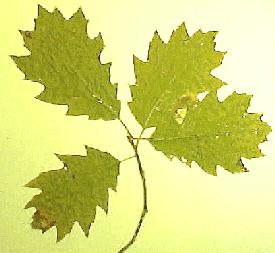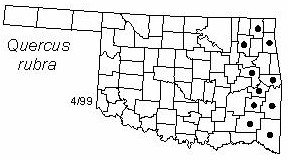
Large tree to 25 m tall (80 ft) and 1 m (3 ft) diameter. Twigs slender, dark reddish brown, with star-shaped pith, ending in a cluster of pointed dark red glabrous buds. Bark dark gray or black, furrowed into broad hard scaly ridges, inner bark reddish to pink. Leaves alternate, elliptical, 10-25 cm (4-10 in) long and 8-15 cm (3-6 in) wide,divided less than halfway to midvein into shallow wavy lobes with a few irregular bristle-tipped teeth, glabrous dull green above, light dull green below with tufts of hairs in vein angles. Fruits are acorns maturing in the second year, about 1.5-3 cm (0.6-1.2 in) long, with a broad usually shallow cup.
Distribution: Native to the eastern half of the U. S. and southeastern Canada.
Habitat: oak-hickory, oak-pine, and well-drained floodplain forests.
Comment: This is one of the most important producers of red oak lumber. Quercus is the ancient classical name for the European oaks; rubra refers to the reddish wood.
NWI status: FACU+
Distribution in Oklahoma: 
BACK
NEXT
RETURN TO INDEX
Last update: 9/17/99
 Go to Oklahoma Biological Survey Home Page
Go to Oklahoma Biological Survey Home Page
 Disclaimer
Disclaimer